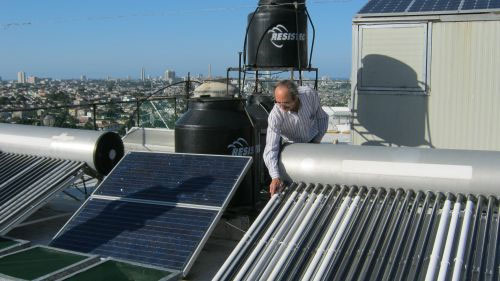Clean energy future for Cuba
Over the past decade, solar power has changed the lives of many Cuban mountain communities. Solar energy along with other renewable energy sources is being considered the best option for sustainable energy development in this Caribbean island nation.
Luis Bérriz, head of the Cuban Association for the Promotion of Renewable and Respected Environmental Resources (CUBASOLAR), said the total amount of solar radiation that Cuba receives each day is equivalent to 50 million tons of oil. Accordingly, if the solar panels are to be installed on highways about 1,000km long, it is certain that Cuba will have the necessary energy resources to meet the domestic consumption demand without using natural fuel. fossil fuels or up to one square meter of agricultural land.

Mr. Luis Bérriz is conducting a check on a battery
Solar (Photo: Jorge Luis Nanos / IPS)
He commented that Cuba should quickly shift from using oil to using other clean energy sources, first of all from raising the level of awareness, technology as well as the expertise and necessary skills of the team. labor force.
In 2010 alone, wind power, hydropower and sugarcane biomass contributed about 178GWh to the Cuban National Electricity System, equivalent to a 4-day continuous consumption across the country and in place of nearly 46,000 tons of oil.
According to official statistics published by CUBASORLAR in Energía y Tu magazine, the country now has 9,624 solar panels, 8,677 windmills, 6,447 solar cells, 554 gas plants. biology, 173 hydropower plants, 4 wind farms with about 20 wind turbines and 608 kilns producing wood biomass pellets. In addition, Cuba has 57 turbine generators and 67 boilers at 61 sugar plants.
In order to make the Cuban firm step forward on the development of clean energy, many experts believe that besides issuing the right decisions to modernize and improve the efficiency of the economy, this island nation There needs to be a specific support mechanism to accelerate the introduction and use of alternative devices towards sustainable energy development without putting a burden on the state government.
This will also be an attractive and reliable option for foreign investors, as well as a motivation for national industries to use new renewable energy sources.
- Energy for the future
- Cuba operates the second solar park
- Successful development of clean energy
- Interesting little facts about Cuba
- Vietnam won the Global Energy Award
- Solar cells will be usable at night
- The future for wind power
- Learn about bio-batteries - Green energy sources in the future
- Successfully manufactured the world's first 'thermal energy battery'
- 'Ice blaze' - discovered to help find clean and stable energy sources in the future.
- The world needs to accelerate the application of clean energy
- Energy Observer - 'Laboratory' of floating energy throughout the world
 Is the magnetic North Pole shift dangerous to humanity?
Is the magnetic North Pole shift dangerous to humanity? Washington legalizes the recycling of human bodies into fertilizer
Washington legalizes the recycling of human bodies into fertilizer Lightning stone - the mysterious guest
Lightning stone - the mysterious guest Stunned by the mysterious sunset, strange appearance
Stunned by the mysterious sunset, strange appearance